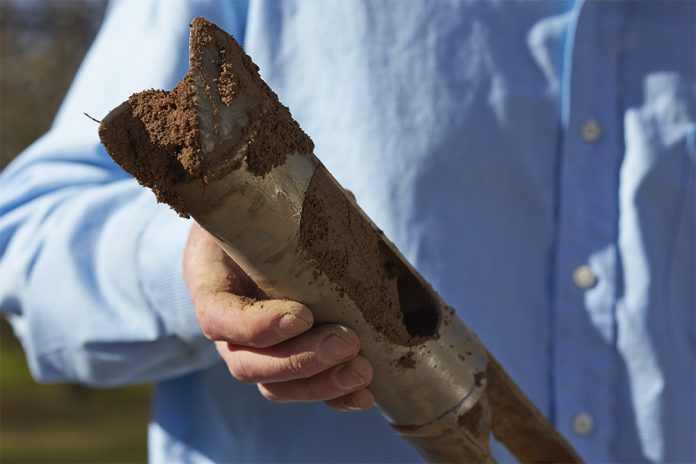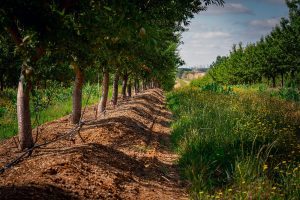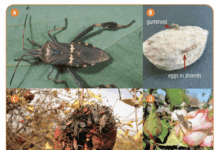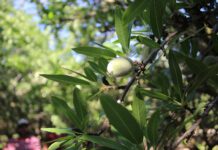
Agriculture consultant Bill Brush said he wants growers to stop looking up when they enter an orchard and start looking down.
“They look up because that is where the crop is,” he said. “But I always say take that vision and look down because down is where all this crop is made from. The nutrients are down in the soil.”
Brush, an orchardist and CEO of B&B Ag Consulting in Modesto, presented a theme that resonated across presentations at the Almond Board’s 2023 summit: Soil is the most important factor in a healthy cropping system.
“I want to get a generation of people that are looking down first seeing that soil tilth, the soil health and how my soil is working,” he said. “And then we’ll see how well it’s doing in the field.”
Brush was joined by Eryn Wingate, lead agronomist for Tri-Tech Ag Products and a board member of the Western Region Certified Crop Advisers, in a Soils 101 presentation that provided an overview of the different components of soil health and set the stage for the summit.
“Healthy soils store water,” said Wingate. “They sequester carbon. They resist erosion, which is very important now as we’ve had some record storms, and we expect that severe weather events will continue.” And, she said, healthy soils help growers optimize yield potential and water use.
At its most basic, soil needs two elements to function, Brush said: air and water. “If the microbiology can’t get air, it’s not going to survive. It’s going to sit there in a spore form or in some form that will come back to life when it gets the proper amount of air and water,” he said.
Healthy soils also need balanced soil biology, including mold, yeast, fungi, bacteria and microbes, which help in nutrient cycling, breaking down crop residue and plant growth stimulation.
“And if you don’t have your soil balanced, where you can get air down into that soil and get water to move through that soil profile, you’re not ever going to be really successful at growing the top yields and sustaining yourself for the long haul,” Brush said.
Soil Profile
Use of compost, cover crops and whole orchard recycling all can assist in creating a balanced soil profile, according to presenters.
Josette Lewis, chief scientific officer of the Almond Board, noted that Almond Board research has shown continuous soil coverage afforded through cover crops, for example, is correlated with increased levels of the mycorrhizal fungi that play important roles in plant nutrition. “And it helps with some of those properties like nutrient cycling, combating soil pests and so forth,” she said.
“We have also done research on compost, and we have some additional research that is just getting started this year,” she said. “We have mixed results in terms of actual yield benefits for compost, but some good evidence that it can be an important way to achieve some of the nutrients that you need in the orchard.
“Then we have whole orchard recycling,” Lewis said, “and there is no practice that can add that much organic matter in such a short time. Obviously, you only do it once in the life of an orchard: When you take an orchard out and plant a new one. But it is a really valuable practice. It is expensive and logistically sometimes complex, but it is a valuable practice when it comes to adding significant organic matter and really giving a shot in the arm in that soil for the next orchard.”
Lewis’ comments were followed by a presentation that included first-hand experience from orchard managers who work with cover crops.
Donnie Hicks, a grower who works in grower relations with RPAC Almond Growers and Processors, said he initially looked into utilizing cover crops to provide food for bees for his 18-acre almond orchard.
“And then also, we have a sandy loam soil, which is great, but when we get into the later summer months, the soil seems to close up and I can’t get water to infiltrate past about a foot,” he said. “So, I heard cover crops would help that.”
Two years into using cover crops, Hicks said the practice has helped increase soil organic matter and improve water infiltration. The cover crop also helped him get access to his orchard in the dormant season despite winter storms that brought so much water.
“That was a great benefit,” he said.
“I definitely plan to do this every year,” he said. “It’s definitely worth your while, for big and small farms to do cover crops, not just for the pollinator benefits but the soil benefits as well.”

Multiple Benefits
Zac Ellis, senior director of agronomy for Olam Food Ingredients, who manages 14,000 acres of orchard crops including mostly almonds, said he has seen significant benefits from working extensively with cover crops over the past seven years.
“When I was just starting with Olam, we were one of the first orchards that developed different trial work with the Xerces Society and on what mixes of cover crops they wanted to deploy commercially to their certified body,” he said. “So, right out of the gate, we were doing trials on different types of mixes, planting depths, how to irrigate, when to irrigate, when to plant.
“So, over the years, we’ve really tried to understand why we’re doing these things and what the benefit is,” Ellis said.
Ellis said the company eventually came to realize the best way to benefit from cover crops was in relation to IPM, or integrated pest management. The system included discontinuing use of some broad-spectrum insecticides.
“What we are seeing is that by eliminating some of the harmful pesticides, in addition to permanent and annual cover crops, we could see a huge increase in six-spotted thrip, and over two or three years of doing that consistently, now we don’t spray for mites. Even at hull split, there are no miticides in the tank,” he said.
“The biggest issue I see [with cover crops],” Ellis said, “is that it takes multiple years for you to see a lot of benefits. These types of regenerative practices, increasing biodiversity both in the soil and above ground for pollinators, take multiple years to build.
“Once you get to that critical mass in building that soil health, you see a huge benefit in multiple ways, including nutrient use efficiencies, and we’ve been able to cut our irrigations without any detriment to our crop. There is just a host of things that are now starting to really click for us.”
The summit also included presentations on pest and weed management and organic soil amendments as well as cost share opportunities available for soil health programs. Among cost share programs highlighted were the California Department of Food and Agriculture’s Climate Smart Land Management Program, a Healthy Soils Incentive grant program, which provides up to $100,000 to increase soil organic carbon and reduce greenhouse gas emissions, and a State Water Efficiency Enhancement Program (SWEEP), which provides up to $200,000 for projects that can show an increase in water-use efficiency.
“Our incentive programs through the healthy soils program allow farmers and ranchers to adopt these practices while minimizing financial risks to their operations,” said Virginia Jameson, CDFA deputy secretary for climate and working lands in a presentation at the summit. “Farmers can improve the health of their soils and reduce greenhouse gas emissions.”
And maybe, as Brush would like, farmers will start looking down rather than up when first entering an orchard.











